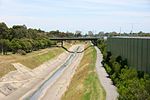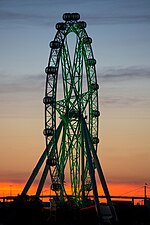Melbourne West Province
Melbourne West Province was an electorate of the Victorian Legislative Council from 1904 until 2006.It was created in June 1904 when Melbourne Province was reduced in size (four members down to two), North Yarra Province and South Yarra Province were abolished. The new Melbourne West Province, Melbourne North Province, Melbourne South Province and Melbourne East Province were then created. Its area was defined by the Electoral Provinces Boundaries Act 1903 as: Commencing at the intersection of Elizabeth-street and Victoria-street; thence westerly by Victoria-street and the boundary of the city of Melbourne to the Saltwater River; thence southerly by that river and the Yarra River to the Coode Canal; thence easterly by that canal and the Yarra River to Clarendon-street; thence south-easterly by Clarendon-street to Dorcas-street; thence south-Westerly by that street to Nelson-road ; thence southerly by Nelson-road to St. Vincent-street west; thence south-westerly by that street to Cowie-street; thence north-westerly by Cowie-street to Pickles-street; thence southerly by that street to the shore of Hobson's Bay ; thence westerly and southerly by the shore of Hobson's Bay and westerly by the shore of Port Phillip Bay to the west boundary of the town of Williamstown (as described in the Local Government Act 1890) ; thence north by the said boundary to Stony Creek ; thence north-westerly by that creek to Reid-street; thence west by that street to the Geelong-road ; thence south-westerly, west, and southerly by that road to the Kororoit Creek ; thence northerly by that creek to the west boundary of section 18, parish of Cut-Paw-Paw ; thence north by the west boundaries of sections 18, 19, and 22 to the Saltwater River ; thence easterly by that river to Maribyrnong-road ; thence easterly by that road and the south boundary of allotment i), section 5, parish of Doutta Galla, to the Moonee Ponds; thence southerly by the Moonee Ponds to Flemington-road ; and thence south-easterly by that road and Elizabeth-street to the commencing point. To include the electors afloat in Hobson's Bay. Melbourne West Province was abolished at the 2006 state election in the wake of the Bracks Labor government's reform of the Legislative Council.
Excerpt from the Wikipedia article Melbourne West Province (License: CC BY-SA 3.0, Authors).Melbourne West Province
Lorimer Street, Melbourne Port Melbourne
Geographical coordinates (GPS) Address Nearby Places Show on map
Geographical coordinates (GPS)
| Latitude | Longitude |
|---|---|
| N -37.816666666667 ° | E 144.93333333333 ° |
Address
Bolte Bridge
Lorimer Street
3207 Melbourne, Port Melbourne
Victoria, Australia
Open on Google Maps







